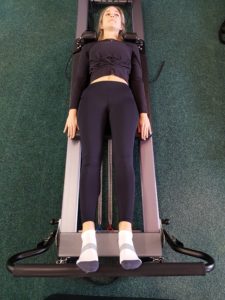In this blog series, we are breaking down the Reformer, taking all the exercises you know and love to hate, and giving you the why and the how to perfect your technique as well as some things to think about the next time you tackle a particular exercise.
“Ok so let’s take the heels to the footbar, fist distance apart, inhale to prepare, engage your core first and then start to push away”
 If you have been to a Flex Reformer Pilates class, you’ll know we always start with footwork and if you have been to a few classes, it’s easy to think of this as ‘just a warm up exercise’. So let’s dive a little deeper into your footwork series and see can we get you a little more bang for your buck. Pilates footwork is simple but powerful and is key to your Reformer session – it often dictates how the rest of the session is going to go, pinpoints any imbalances for you and for your teacher, and it’s the perfect option to work in a decompressed position (for the spine) while challenging control, underused muscles, and joints.
If you have been to a Flex Reformer Pilates class, you’ll know we always start with footwork and if you have been to a few classes, it’s easy to think of this as ‘just a warm up exercise’. So let’s dive a little deeper into your footwork series and see can we get you a little more bang for your buck. Pilates footwork is simple but powerful and is key to your Reformer session – it often dictates how the rest of the session is going to go, pinpoints any imbalances for you and for your teacher, and it’s the perfect option to work in a decompressed position (for the spine) while challenging control, underused muscles, and joints.
Start as you mean to go on
Once you start your footwork series, you have started your Pilates class and you should be putting effort in. Plenty of effort in fact! You need your body to know that it is time to wake up and start working. Pilates is a system, it is so much more than a series of exercises just thrown together and the sequencing of the exercises matters. This is one of the reasons we always start with footwork. Our goal here is to get you moving, to warm up all the systems in the body and start to improve circulation. It also helps to ‘ground’ you to the Reformer, to tune into how your body is feeling today (are there any ‘sticky’ or stiff spots) and to dial into your breathing to activate your core. The goal of footwork is to strengthen your entire leg, especially the back line of the body (think glutes and hamstrings), to strengthen your pelvis in a neutral position, to work your core to assist in stabilising your pelvis and lengthening your spine and to start to stretch the hip flexors at the front of the hip. So already, there is a lot going on and you need to be present in the exercise to get the benefit.
Things to keep in mind
- Power the movement from the hamstrings (back of the thigh) and the glutes (seat muscles). All too often, we let our quadriceps (front of the thigh) take over the heavy lifting in footwork when very, we should be allowing them to stretch. As you push the carriage out, think push either through the heel (heel on bar) or with the heels sky high (toes on bar) and move from your hamstring, pulling your kneecap up and allowing the very front of your hip to open and lengthen
Use your entire body 
We know it’s called ‘footwork’ but is there ANY exercise in the Pilates system that just works one area of your body? No, and that is the beauty of the system! Start as you mean to go on by thinking about your body as a whole unit – not just a collection of muscle groups. Your core or Pilates powerhouse should be involved from the get go to allow you to find the strongest position to work your hips and legs.
Things to keep in mind
- Use your arms! We can be tempted to let the arms rest on the mat but see how it feels to reach your fingertips all the way to the springs, press your palms and your triceps into the mat and keep the back of the arm connected the entire time. This will help you to breath deeper into your ribs and help you to keep your ribs connected to your core throughout the exercise.
- Use your breath! Dialling into a pattern of exhaling the carriage away and inhaling the carriage home can help you find a rhythm which will encourage a more fluid movement.
- Use your feet! We know you’ll feel your hamstrings and your seat singing as those legs get challenged in footwork but don’t forget your feet! When you have your toes on the bar, it’s important to have every toe, even your baby toe on the bar. When you have the arches of your feet on the bar, remember to wrap your toes forward and your heels push forward to lift the deep internal arch of the foot to strengthen the muscles in the feet.
 Alignment matters
Alignment matters
When you come to lying down on the Reformer, your teacher will always check your alignment but it is important you become familiar with getting yourself into your ideal position. You should by lying right into the centre of the mat with your head in the centre of the headrest. For most people, it is more comfortable to have the headrest elevated – this also allows you to get a deeper connection to your core by helping you to connect your ribs to your abdominal core. Your feet should be equal distance from either end of the footbar and you are looking for the centre of the crease of your hip to line up with the centre of your kneecap, the centre of the front of your ankle joint and your middle toe. Watch as you press the carriage away that your knees don’t wander away from or towards each other and that you are creating the power for the movement from your hamstrings and your seat.
As always, check in with your teacher before or after class if you have any questions about your footwork series – never be afraid to dial into exercises that might seem basic, those are the ones that often hold the key to unlocking your strength for more complicated Pilates exercises.



Definitely have been guilty of not putting the effort in at the start of class. Sometimes the more I think I know, the more I have actually forgotten and getting back to the basics (yet essentials) is always a good idea. I have a lot of blog to catch up on but this is great resource.